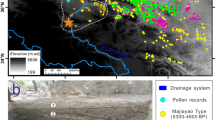Abstract
The late Bronze Age lakeshore settlements of Grésine (French Alps) have yielded archaeobotanical evidence of 14 cultivated and 153 wild plants. Some of the wild taxa may have been collected, but many are probably here by chance. Three criteria are used as evidence for human transport and manipulation of wild plant remains: number of items, fragmentation, and carbonization. Relations between these criteria and known ethnobotanical properties of the identified plants are statistically analyzed. Results display good evidence of the gathering of edible wild fruits and seeds. Other gathering practices are not documented. Edible fruits and seeds seem to have been gathered mainly from ruderal spring weed communities and, possibly, from forest clearances and hedge communities. Fragmentation appears to be less of a discriminating factor than number of plant remains and carbonization.
Résumé
Les sites lacustres de lâge du Bronze final de Grésine (Alpes françaises) ont permis láttestation archéobotanique de 14 plantes cultivées et de 153 plantes sauvages. Certains des taxons sauvages ont pu être cueillis mais nombre d’entre eux sont probablement présents par accident. Trois critères sont utilisés pour montrer un apport et un traitement de ces plantes par l’homme: la représentation quantitative, la fragmentation et la carbonisation. Les relations statistiques entre ces critéres et diverses propriétés ethnobotaniques sont analysées. Les résultats convergent pour attester la cueillette de fruits et graines sauvages comestibles. Aucune autre pratique de cueillette nést mise en évidence. Les semences et fruits alimentaires proviennent plus particuliérement des groupements de mauvaises herbes des cultures sarclées ou de printemps ainsi que, peut être, des fruticées, haies, lisiéres et clairiéres. Le taux de fragmentation est un caractère moins discriminant que la représentation quantitative et la carbonisation
Similar content being viewed by others
Literature Cited
Agresti, A. 1990. Categorical data analysis. John Wiley & Sons, New York.
Billaud, Y., andA. Marguet. 1997. L’archéologie subaquatique dans les lacs alpins français. Pages 219–264 in J. P. Bravard and M. Prestreau, eds. Dynamique du paysage. Entretiens de géoarchéologie. Dara, 15. Service Régional de l’Archéologie, Lyon.
Boardman, S., andG. Jones. 1990. Experiments on the effects of charring on cereal plant components. Journal of Archaeological Science 17:1–11.
Bouby, L., andY. Billaud. 2001. Economie agraire à la fin de l’áge du Bronze sur les bords du lac du Bourget (Savoie, France). Comptes Rendus de l’Académie des Sciences Paris, Sciences de la Terre et des planétes 333:749–756.
Couplan, F. 1989. Le régal végétal. Plantes sauvages comestibles. Editions Equilibres, Flers.
Dennell, R. W. 1976. The economic importance of plant resources represented on archaeological sites. Journal of Archaeological Science 3:229–247.
Dietsch, M. F. 1996. Gathered fruits and cultivated plants at Bercy (Paris), a Neolithic village in a fluvial context. Vegetation History and Archaeobotany 5:89–97.
— 2001. Milieux humides préet protohistoriques dans le Bassin Parisien: L’étude des diaspores. Presses Universitaires du Septentrion, Villeneuve DÁscq.
Dobremez, J. F., M. R. Dumas, M. G. Dupias, P. Gensac, P. Ozenda, G. Pautou, M. F. Pautou, M. P. Rey, L. Richard, andA. Tonnel. 1979. Carte de la végétation de la France. Nµ54, Grenoble. CNRS, Paris.
Ellenberg, H. 1988. Vegetation ecology of Central Europe. Fourth edition. Cambridge University Press, Cambridge.
Guinochet, M., andR. DeVilmorin. 1973–1984. Flore de France. CNRS, Paris, 5 vol.
Helbaek, H. 1960. Comment on Chenopodium album as a food plant in prehistory, Berichte des geobotanischen institutes der Eidgenössischen Technischen Hochschule, Stiftung Rübel, 31:16–19.
Jacomet, S., C. Brombacher, and M. Dick. 1989. Archäobotanik am Zürichsee. Züricher Denkmalpflege, Monographien 7, Zürich.
Jacquat, C. 1989. Les plantes de l’âge du Bronze. Contribution à l’histoire de l’environnement et de l’alimentation. Archéologie neuchâteloise, 8. Editions du Ruau, Saint-Blaise.
Lundstöm-Baudais, K. 1989. Etude des paléosemences de la station II. Pages 193–194 in P. Pétrequin, ed. Les sites littoraux de Clairvaux-les-Lacs (Jura). Le Néolithique moyen, Tome, II. Maison des Sciences de l’Homme, Paris.
Marinval, P. 1988. L’alimentation végétale en France du Mésolithique jusqu’à l’Age du Fer. CNRS, Toulouse.
Maurizio, A. 1932. Histoire de l’alimentation végétale depuis la préhistoire jusqu’á nos jours. Payot, Paris.
Siegel, S. 1956. Nonparametric statistics for the behavioural sciences. McGraw-Hill, Kogakusha, Tokyo.
Willerding, U. 1991. Präsenz, Erhaltung und Repräsentanz von Pflanzenresten in archaologischem Fundgut. Pages 25–51 in W. van Zeist, K. Wasylikowa, and K.-E. Behre, eds. Progress in old world palaeoethnobotany. Balkema, Rotterdam.
Wilson, D. G. 1984. The carbonization of weed seeds and their representation in macrofossil assemblages. Pages 201–206 in W. van Zeist and A. Casparie, eds. Plants and ancient man. Balkema, Rotterdam.
Author information
Authors and Affiliations
Corresponding author
Rights and permissions
About this article
Cite this article
Bouby, L., Billaud, Y. Identifying prehistoric collected wild plants: A case study from late bronze age settlements in the french alps (Grésine, Bourget Lake, Savoie). Econ Bot 59, 255–267 (2005). https://doi.org/10.1663/0013-0001(2005)059[0255:IPCWPA]2.0.CO;2
Received:
Accepted:
Issue Date:
DOI: https://doi.org/10.1663/0013-0001(2005)059[0255:IPCWPA]2.0.CO;2




